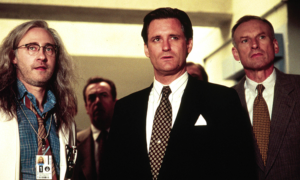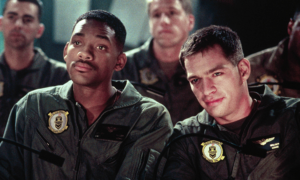It may be difficult now to appreciate the colossal impact the teaser trailer for the original Independence Day movie had on audiences back in 1996. The appearance of an all-encompassing shadow engulfing iconic US landmarks, followed by the unbelievable sight of the White House suddenly being blown to smithereens, was quite simply jaw-dropping. To put things into perspective, this was a time before the horrific events of 9/11, before the spoilery consequences of the internet, and when cinemagoers held onto trailers alone to provide an intricate glimpse of what to expect from an eagerly anticipated blockbuster.
“Roland Emmerich didn’t compromise. He went all the way. He went huge! You had this insane scale of annihilation which had never been attempted before,” considers production designer Patrick Tatopoulos regarding the approach of the now renowned master-of-disaster director, who would go on to helm additional apocalyptic flicks like The Day After Tomorrow and 2012. “We were trying to communicate how small we are in the universe, how much larger an alien croft coming toward us could be, and if an invasion happened that it could be that incredible.”
Indeed, this was a world away from the ‘we come in peace’ style of cutesy aliens in – relatively small in comparison – spacecrafts and flying saucers seen in the likes of ET and Close Encounters Of The Third Kind.
Instead, these were malevolent War Of The Worlds-style extraterrestrials with an aggressive sense of global entitlement. From the outset it was painfully clear that this wouldn’t be a close encounter of the friendly kind.
“We started to talk about what the worldwide alien invasion would look like. What would happen if these things were unstoppable?” Independence Day scribe Dean Devlin tells us. “It was the destruction of these iconic [buildings] that made you feel, ‘If they can blow up the White House, how do we ever stop them?’”

A close collaborative process was forged between Devlin and director Roland Emmerich – both of who had worked together on 1994’s time travelling science fiction fantasy Stargate – to bring this mass visualisation to life. “As we started working on it, Roland came up with these images, these visual ideas,” continues Devlin. “I would sit at one end of the table with a laptop working on a scene, and he sat at the other end with a sketchpad. He was literally drawing the scene that I had not yet written. When I’d finished writing a scene we would exchange, and I’d look at his drawings and he would look at my pages. Then we would change what we liked better.”
Not that the scribe was initially set on the idea of an alien-invasion flick in the first place. “When Roland first started talking to me about doing the movie, I actually didn’t want to do it because I thought Spielberg had already done such a great job with aliens [in] Close Encounters – so how could we possibly top it?” he admits. “Roland kept talking about the images he wanted to do, which seemed really original. And I said, ‘Well what if we don’t deal with the aliens as evil bad guys, but more like a force of nature and did this like a disaster film?’ and he said, ‘That’s exactly what I want to do!”‘
The filmmakers were inspired by classic Seventies disaster movies, and embraced the concept with a knowing sense of irony. This included enlisting a rich and recognisable ensemble cast – including some of today’s superstars – portraying a colourful array of characters who come together in the face of disaster.
“It was very much like a Seventies Irwin Allen movie; the photography, the style, the staging of the actors – we really studied movies like The Towering Inferno, The Poseidon Adventure and Earthquake. It was definitely a conscious effort to mimic those kinds of films,” reveals Devlin. “I think the success of Independence Day is attributed to how much the audience fell in love with these characters. Whether it’s Will Smith going AWOL to find his [future] wife, Randy Quaid sacrificing his life for his children or the father-son relationship with Jeff Goldblum, the characters have so much love for each other, and I think that’s what made it infectious and relatable.”

Looking back at the film now, it’s difficult not to be overwhelmed by its rather overtly American patriotic can-do message. However, Devlin points out that it evolves into a much broader spectrum of humanity. “It was meant to take a patriotic experience, which then becomes an international patriotism,” he explains. “To start with, there’s this idea that Independence Day is so related with an American holiday, but now it’s all humanity related against a common enemy. So we wanted that sense of patriotism to go beyond borders and [be] patriotism for humanity.”
As one of two production designers working on Independence Day (the other being Edge Of Tomorrows’ Oliver Scholl), Patrick Tatopoulos reveals it was the simple but terrifying concept of the ship emerging from the clouds and blanketing the sky that helped put things into perspective. “Someone said, ‘You wake up in the morning, step out the door of your house, and the sky has suddenly turned mechanical,” he reflects. “The idea that it’s not just look up in the sky and there’s a big aircraft – it’s you look up in the sky and it’s a mechanical engine now! That concept basically drafted the look of the film and how we were to approach it.”
Tatopoulos was also tasked with designing the primal alien threat, a tricky concept when you consider the countless number of on-screen extraterrestrials that had come before. “The interesting thing is there were two different designs that we showed to Roland, and he said that he liked them both, so this very interesting concept came up to incorporate both ideas,” reveals the production designer. “One of the ideas that I loved was that this small alien inside the big one is actually the true alien – because, being a very fragile alien, it would be travelling inside a suit [which is] now on orgonic being. It’s almost like a man covering himself in the skin of a bear. So the concept of the alien was those two designs combined.”
Totopoulos explains that it’s the absence of eyes that can make a foreign creature intimidating. “Nothing is scarier to me than something that doesn’t have eyes, because you don’t see any emotion,” he admits. “The finest example is the creature in the original Alien or the Predator [before he’s unmasked] – you don’t see their eyes. You don’t know what these creatures feel. You don’t know if they’re scared. The main alien in Independence Day has very small gaps where the eyes would be, but you don’t see them, which means you don’t see emotion: that’s scary!”
Equally crucial was the design of the alien spacecraft – from the legion of small alien-piloted ships and the substantial attacker that can instantly obliterate cityscapes to the mammoth Earth-orbiting mothership. “We looked at films like Close Encounters and Aliens, but we were genuinely trying to bring something fresh,” he explains. “For many years I’ve been trying to work both hands of the spectrum: designing the set and also working on the creatures.
“The reason for that is because the world has to have the right fit for the creatures. When I designed the alien I also designed the small craft, the attacker, the destroyer and the mothership: all those things have to feel a part of the same civilisation. When we finished we looked at the alien head and the attacker, and we realised that the top of the alien head looks exactly like the aircraft – it was two designs without really thinking about it. That sort of thing comes instinctively.”
Although Independence Day was seen as a turning point for CGI visual effects, resulting in those memorable Oscar-winning shots of mass destruction, an overlooked aspect was the practicality of the creatures, which combine carefully integrated man-in-a-suit aesthetics, mechanical effects and alien puppets. “CGI was not good enough then to shoot in close-up, so you would use puppets or make-up and then use CGI for the wide shot of the creature,” says Tatopoulos. “Every time you see the alien from the torso up it’s someone inside the suit. But when you see the whole alien and it starts walking it’s actually a small-scale puppet that we shot on green screen.”
In order to maintain that imperative design continuation, Tatopoulos was appointed as a visual consultant on the 20-years-later sequel Independence Day: Resurgence. “I worked with them for about three months to bring that style and texture back,” he says. “They have created such a back story and an aesthetic for the aliens that they wanted to keep that tradition.”
Devlin, who’s a producer on Resurgence and wrote the initial draft with Emmerich, reveals he’s happy with the way the sequel has evolved – both as a throwback to the original for fans and as a handing down of the torch to a new generation. “I’m really proud of this movie. For years I didn’t want to do a sequel,” he admits. “In fact, not long after 9/11, I’d written a sequel that we never handed in because I didn’t feel it was worthy. I’m really pleased that we’ve finally been able to do one that is a worthy successor.”
Despite some unbelievably far-fetched sequences (including that infamous moment Vivica A Fox and her just-in-the-nick-of-time canine companion menage to escape an erupting inferno by using the exit door), the original Independence Day remains a brazenly entertaining popcorn disaster flick, which knowingly embraces genre cliches for a pumped-to-the-max thrill ride. Just don’t take it all too seriously.
Independence Day is available to buy on DVD and Blu-ray now.
